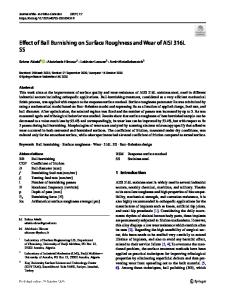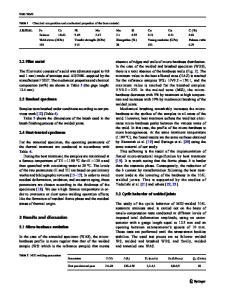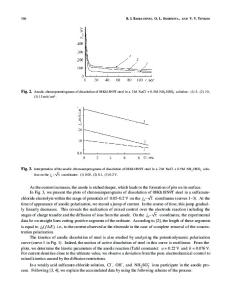Effect of Ball Burnishing Treatment on the Fatigue Behavior of 316L Stainless Steel Operating Under Anodic and Cathodic
- PDF / 2,805,768 Bytes
- 9 Pages / 593.972 x 792 pts Page_size
- 26 Downloads / 282 Views
.
INTRODUCTION
CORROSION fatigue (CF) is the combined effect of alternating and cyclic stresses on metals that cause early failure under the influence of an aggressive environment.[1] In ships, propeller shafts are the components that are most exposed to vibrations, torsions, and various bending stresses under the influence of the corrosive effect of seawater.[2,3] Because of the effect of those factors, fatigue fracture damage can occur in propeller shafts over time.[4] Therefore, propeller shafts are often made of austenitic stainless steels, which show high corrosion resistance, good toughness, and ductility.[4,5] In case of long-term exposure of austenitic stainless steels to salt water, an anodic reaction occurs that leads to pitting and crevice surface corrosion.[6,7] Poonguzhali et al.[8] examined the corrosion fatigue behavior of AISI 316LN in acidified sodium chloride solution at applied potentials. Fatigue experiments were performed with cyclic loading at a frequency of 0.1 Hz. According to the results, pitting potential applied during fatigue experiments increased pit formation and caused microcracks that would lead to premature damage.
HASAN YILMAZ and RECEP SADELER are with the Department of Mechanical Engineering, Faculty of Engineering, Atatu¨rk University, 25240 Erzurum, Turkey. Contact e-mail: [email protected] Manuscript submitted March 3, 2017.
METALLURGICAL AND MATERIALS TRANSACTIONS A
Cathodic protection is the main method of preventing local corrosion of stainless steel on ships that are in contact with sea water. It is based on the principle of decreasing the potential value.[9,10] Bellezze et al.[9] reported that biofilms formed over time on surfaces of the ship components that are in contact with water deactivate the effects of the cathodic protection, which increases the corrosion risk by raising shaft potential. Lenard et al.[11] experimentally investigated the effect of stray currents on the propeller shafts of the ships. They verified that the leakage currents passing through the AISI 316L shaft could accelerate the corrosion process by initiating crack corrosion within three days. On ships, anticorrosive paint is being used, or grounding plates to the body are being mounted, to protect stainless steel shaft systems from corrosion effects. However, the problem still continues, and no definitive alternative technology solution has yet been found.[10,12] To improve the efficiency and quality of the rotating shafts, ball burnishing (BB) has been presented as a mechanical surface treatment in recent years.[13–15] As shown in Figure 1, BB treatment consists of rolling a hard-ball pressed onto the surface by hydraulic pressure. Moving the tool causes the polishing ball to roll over the surface, thereby plastically deforming micro-peaks into the micro-valleys on the surface and causing the surface irregularities to be smoothed out.[16] For the first time in this study, the operating conditions of the ship propeller shafts in a corrosive and cathodic environment were simulated. AISI 316L austeniti
Data Loading...










